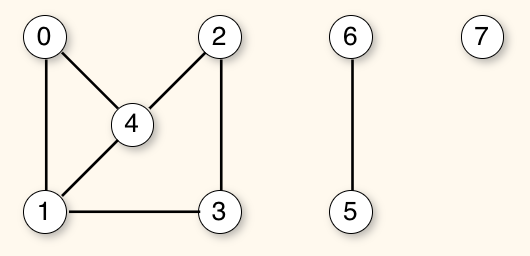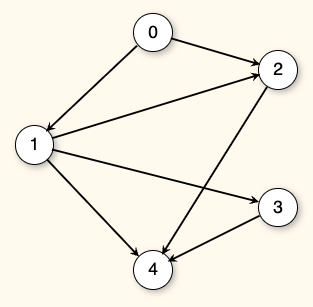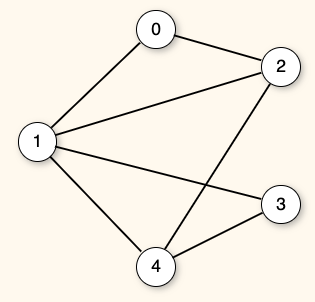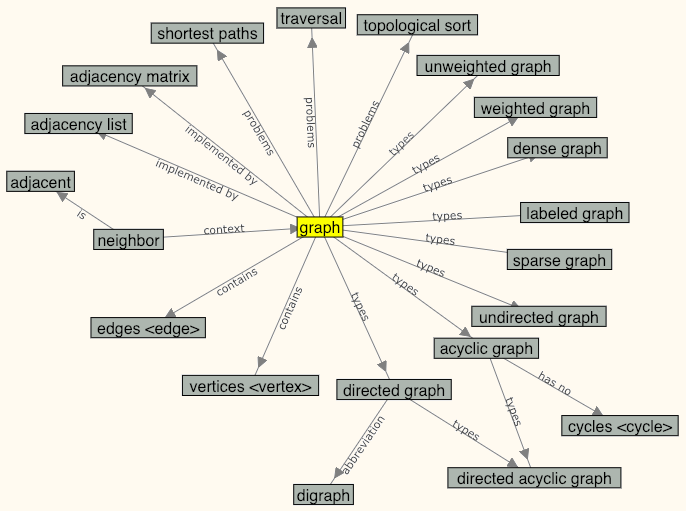13.11 Review questions
This final section contains some review questions about the contents of this chapter.
13.11.1 Review questions: Graph terminology
When a vertex is connected by an edge to a vertex , what is the term for their relationship?
- An edge connecting two vertices is incident on these vertices.
- Two vertices connected by an edge are adjacent.
Answer TRUE or FALSE.
Two vertices of a graph are ADJACENT if there is an edge joining them.
- Neighboring vertices are adjacent to one another.
- Two vertices are considered neighbours if there is an edge connecting them.

Answer TRUE or FALSE.
Vertices 3 and 4 are adjacent.
- Two vertices are adjacent if there exists and edge between them.

How many connected components does this graph have?
- The maximally connected subgraphs of an undirected graph are called connected components.
- Vertices 0, 1, 2, 3, and 4 form one connnected component
Answer TRUE or FALSE.
A DAG is a directed graph without cycles.
- A DAG is a Directed Acyclic Graph.
- An acyclic graph has no cycles.
Given a subset S of the vertices in a graph, when all vertices in S connect to all other vertices in S, this is called a:
- A clique is a subset of the graph where all the vertices in the subgraph connect to the other vertices.
A complete graph is a clique of size:
- A graph containing all possible edges is said to be a complete graph
- Any subset of where all vertices in the subset connect to all other vertices in the subset is called a clique
- A complete graph is a clique of size .
A graph containing all possible edges is a _____ graph
- A dense graph is a graph with many edges.
- A sparse graph is a graph with relatively few edges.
- A complete graph is a graph containing all possible edges.
A graph without cycles is called a/an:
- An acyclilc graph has no cycles.
The number of edges incident to a vertex called its:
- An edge connecting vertices is said to be incident.
- The degree of a vertex is the number of graph edges it touches.
A digraph is a:
- A directed graph is also called a digraph.
A graph with directed edges is called a
- A graph with edges directed from one vertex to another is a directed graph.
Answer TRUE or FALSE.
All graphs must have edges.
- A graph is a set of edges and vertcies.
- The set of edges may be empty.
A free tree is:
- A free tree is a connected, undirected graph with no cycles.

What is the out-degree of vertex 1?
- The in-degree of a vertex is the number of edges going into the vertex.
- The out-degree of a vertex is the number of edges going out of the vertex.
- Vertex 1 has an three outgoing and two incoming edges.

What is the in-degree of vertex 2?
- The in-degree of a vertex is the number of edges going into the vertex.
- The out-degree of a vertex is the number of edges going out of the vertex.
- Vertex 2 has an one outgoing and two incoming edges.
Answer TRUE or FALSE.
Two vertices can be adjacent even if they are not neighbours.
- Two vertices are consider neighbours if there is an edge connecting them.
- Neighboring vertices are adjacent to one another.
A simple cycle:
- A cyle is simple if all vertices on the cycle are distinct, with the first and last vertices being the same.
A simple path:
- A path is simple if all vertices on the path are distinct.

What is the degree of vertex 4?
- The degree of a vertex is the number of edges that the vertex touches.
- Vertex 4 has three incident edges.
Answer TRUE or FALSE.
A weighted graph must have edge weights and be directed.
- A weighted graph must have edge weights.
- A weighted graph can be a directed or undirected graph.
13.11.2 Review questions: Graph space requirements
Warning! Read the conditions for the problems in this set very carefully!
Assume for an directed unweighted graph with 6 vertices and 14 edges, that a vertex index requires 2 bytes, and a pointer requires 4 bytes.
Calculate the byte requirements for an adjacency list.
- Since the graph is unweighted, the adjacency list does not store any weight information.
- The adjacency list has an array (of size ) which points to a list of edges.
- Every edge appears once on the list. And for each edge there has to be a vertex ID and a pointer to the next edge.
- It uses bytes.
Assume for an directed unweighted graph with 6 vertices and 14 edges, that a vertex index requires 2 bytes, and a pointer requires 4 bytes.
Calculate the byte requirements for an adjacency matrix.
- Since the graph is unweighted, you can assume that each matrix element stores one byte to represent the edge.
- The matrix is by .
- Each position of the matrix needs one byte.
- It uses bytes.
Assume for an directed weighted graph with 9 vertices and 11 edges, that a vertex index requires 5 bytes, a pointer requires 4 bytes. and that edge weights require 8 bytes.
Calculate the byte requirements for an adjacency list.
- The adjacency list has an array (of size ) which points to a list of edges.
- Every edge appears once on the list. And for each edge there has to be a vertex ID, a weight and a pointer to the next edge.
- It uses bytes.
Assume for an directed weighted graph with 9 vertices and 11 edges, that a vertex index requires 5 bytes, a pointer requires 4 bytes. and that edge weights require 8 bytes.
Calculate the byte requirements for an adjacency matrix.
- The matrix is by .
- Each position of the matrix needs byte.
- It uses bytes.
Assume for an undirected unweighted graph with 7 vertices and 17 edges, that a vertex index requires 6 bytes, and a pointer requires 2 bytes.
Calculate the byte requirements for an adjacency list.
- Since the graph is unweighted, the adjacency list does not store any weight information.
- Since the graph is undirected, each undirected edge is represented by two directed edges.
- The adjacency list has an array (of size ) which points to a list of edges.
- Every edge appears twice on the list (the graph is undirected, so we need the directed edge in each direction). And for each edge there has to be a vertex ID and a pointer to the next edge.
- It uses bytes.
Assume for an undirected unweighted graph with 7 vertices and 17 edges, that a vertex index requires 6 bytes, and a pointer requires 2 bytes.
Calculate the byte requirements for an adjacency matrix.
- Since the graph is unweighted, you can assume that each matrix element stores one byte to represent the edge.
- Since the graph is undirected, each undirected edge is represented by two directed edges.
- The matrix is by .
- Each position of the matrix needs one byte.
- It uses bytes.
Assume for an undirected weighted graph with 10 vertices and 15 edges, that a vertex index requires 1 byte, a pointer requires 2 bytes. and that edge weights require 4 bytes.
Calculate the byte requirements for an adjacency list.
- Since the graph is undirected, each undirected edge is represented by two directed edges.
- The adjacency list has an array (of size ) which points to a list of edges.
- Every edge appears twice on the list (the graph is undirected, so we need the directed edge in each direction). And for each edge there has to be a vertex ID, a weight and a pointer to the next edge.
- It uses bytes.
Assume for an undirected weighted graph with 10 vertices and 15 edges, that a vertex index requires 1 byte, a pointer requires 2 bytes, and that edge weights require 4 bytes.
Calculate the byte requirements for an adjacency matrix.
- Since the graph is undirected, each undirected edge is represented by two directed edges.
- The matrix is by .
- Each position of the matrix needs byte.
- It uses bytes.
13.11.3 Summary questions

Answer TRUE or FALSE.
An acyclic graph can have cycles.
- Look at these terms on the concept map.
A Graph data structure contains ______
- Look at these terms on the concept map.
Another name for “Directed graph” is ______
- Look at these terms on the concept map.
Which of the following is true?
- Look at these terms on the concept map.
A Graph data structure can be implemented by ______
- Look at these terms on the concept map.
A directed graph that has no cycles is a(n) _____
- Look at these terms on the concept map.
Which of these terms does not fit with the others?
- Look at these terms on the concept map.
Which of the following are a type of graph data structure?
- Look at these terms on the concept map.